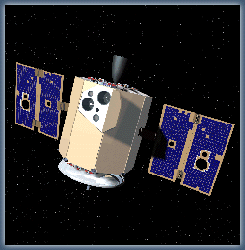Clementine

Clementine was a small lunar probe, built by the United States Naval Research Laboratory and jointly sponsored by BMDO (Ballistic Missile Defense Organization) and NASA as the Deep Space Program Science Experiment (DSPSE).
Clementine's main goal was to space-qualify lightweight imaging sensors and component technologies for the next generation of Department of Defense spacecraft. Intended targets for these sensors included the Moon and the near-Earth asteroid 1620 Geographos.
After two Earth flybys, the probe entered lunar orbit on 21 February 1994. It then mapped the Moon at a number of resolutions and wavelengths, from infrared to ultraviolet, and made laser altimetry and charged-particle measurements over a two-month period, in two parts. The first of these consisted of a five-hour elliptical polar orbit with a perilune (nearest point to the Moon) of about 400 kilometers at latitude 28° S latitude. After one month of mapping, the orbit was rotated to a perilune of latitude 29° N, where it remained for one more month. This allowed global imaging and altimetry coverage from 60° S to 60° N.
Clementine's most important discovery was that of ice under the surface of craters at the lunar poles, later apparently confirmed by Lunar Prospector, but later still called into question. After leaving lunar orbit, a malfunction in one of the onboard computers on 7 May caused a thruster to fire until it had spent all of its fuel, leaving the spacecraft spinning at about 80 rpm with no attitude control. This ruled out the planned asteroid flyby. The spacecraft remained in Earth orbit and continued testing its components until the mission was ended.
| launch date | Jan 25, 1994 |
| launch vehicle | Titan II |
| launch site | Vandenberg Air Force Base |
| size | 1.9 × 1.1 m |
| mass | 424 kg |


